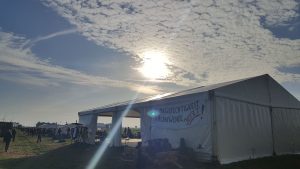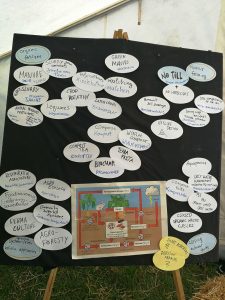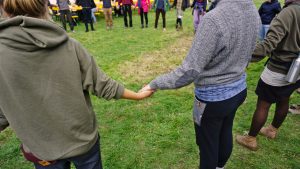A place for connecting
Impressions from the Free the Soil climate and agriculture justice camp in St. Magarethen, September 2019. Several days of sunshine disrupting grey September full of collective learning, action and a burning wish for system change.

People on bikes, by foot, locals from the village and towns around, caravans and travel busses arrive at every hour of the day from Thursday on. Walking past the welcome tent all the necessary information to establish oneself on the camp is handed out. Constantly two people take care of the newcomers giving an introduction to the campsite and St. Maggi (originally St. Margarethen). Even though the camp is shaped as a tube in between a highway and cattle field, there is a clearly arranged map of the entire campsite, telling the newcomers where to put the tent, get food, use the toilet, visit one of the wide range of workshops, or play with kids.
St. Maggi is the small village we choose for the camp, as it is located very close to the YARA factory of Brunsbüttel. YARA is a key player in the machine of industrial agriculture, and is close to having a global monopoly on synthetic nitrogen fertilizers. At the Brunsbüttel plant YARA fixes nitrogen from the air using massive amounts of fossil gas, and produces chemicals for the production of synthetic fertilizers through a highly energy intensive process. In St. Maggi we find ourselves in walking distance to the main target of our protests. Here we feel warmly welcomed by most of the locals and over time a feeling of mutual support is established. More on this later.
At the table in the welcome tent is a little bucket with flowers. On a sticky note on the side of the glass it says ”these flowers were given to us by a YARA-worker”. One morning, an employee at the nearby fertilizer plant, the plant Free the Soil blocked later the same week, stops by to show his sympathy with the camp and our protest. He ends up driving home to pick up eggs and flowers that he handed over to the people at the welcome tent as a gift to the camp! Right across the welcome tent is the huge tent used for meetings, discussion rounds, and concerts. The tent is decorated with several banners demanding agricultural and climate justice. Next to the bar, crêpe and pizza places, the four workshop tents are lined up in a row, filled with straw sacks to sit on, flipcharts and canvas screens ready to be used.
Eventually the campsite provides newcomers an unexpected view: “I was freaked out when I went to wash my hands”, tells Peca. Not only by the great water system set up for the camp, but by “Full cities of containers heavily loaded and enormously polluting cruise ships passing by a few hundred meters from me”. The absurdity of having the Elbe river, a massive industrial waterway, hidden just behind a dike, only one cow-field away is making many associations to sci fi novels, but it is all real and right there, no matter if you come to brush your teeth or go for a cold shower in the tiny collective “shower”.
Logistically building a camp from the bare field is a lot of hassle. Luckily we enjoyed the support of activist’s crews for many tasks. This is indeed a great strength of the anticapitalist internationalist movements in western Europe. The camp runs smoothly with support from two kitchen crews, a bar crew, the pizza crew, the famous ACAB crepes, a bakery van crew, legal team, medics, IT-collective for Wi-Fi, solar-powered sound system and power to the people collective. Actually the camp was 100 % powered by solar panels and a good amount of dedicated comrades – yay!
However, it takes more than the specialized crews help the camp keep on running. Everyone makes their contribution, both in terms of donations to the running costs of the camp, as well as contributions through a participation in mostly reproductive tasks. We do it with pleasure, as we all know that the best conversations often occur when doing practical work together; Cleaning toilets, chopping veggies or taking a shift in the awareness or family spaces.
To be on time each day we have a very regular alarm. Every morning at five an encouraging honking chorus from the passing cars gives us a wake up call to give us energy for another day of learning, protesting, and discussing. Now that we are wide awake that early, we can start preparing the breakfast and have porridge, the delicious self baked sourdough bread and an enormous variety of spreads for everyone. Late starters have to take their breakfast straight to the morning meeting. There the daily workshop programme, important information and individual announcements are discussed with everyone present at the camp.
“At the first morning when everyone gathered for the camp plenary, we were encouraged to introduce ourselves to the person sitting next to us.” Tells Manna, “At my side I had an older person from Brunsbüttel, who admitted that exactly this type of event, was what they longed for 30 years ago – I am so happy to see this camp today, I am just afraid that it is too late’’ they stated.

Later an atmosphere of an ant hub spreads over the camp; full workshop tents and participation at many levels. The camp has a festival-like atmosphere in the sense of a place of connection.
As we are not only protesting against YARA, the whole range of topics connected to climate justice and agriculture in the broadest sense are discussed.
We don’t go after the individual farmer – we target the system. The Industrial agricultural system and its key players and profiteers. YARA is a little-known, enormous and dangerous company profiting on feeding and expanding the market for nitrogen fertilizers and other agro inputs.
There is a big range of workshops; a detailed introduction to the chemical processes of nitrogen fertilizers, an excursion to the peatlands of the area, and workshops on YARA’s greenwashed lobby activity in the Global South.
The picture shows the results of a collective brainstorm giving an overview of alternatives to using synthetic fertilizers.
The workshops are carried out by people from climate or agricultural movements. Most are included in the preplanned program, but additionally groups and individuals come with spontaneous contributions as the camp has a continued call for open space.
On evenings we enjoy panels and fishbowl discussions. The idea behind these is to create a platform for farmers, activists, students and workers to discuss the simple question of the future of agriculture. A topic that comes up often is the difficulty of being a farmer and being politically active, an activist at the same time. Maybe this is where Free the Soil as a campaign comes in to make the link.
When people tumble out of the plenary tent in the starlit night, one meets around the fireplace for a beer or soda and good conversation, mostly in English, but also Danish, German, Dutch, Swedish, French and Spanish are heard amongst the medley of voices.

So, how many people came to the camp? There is a current fluctuation though at our estimated peak there are 300 tents and for dinner about 650 plates served. As we get closer to the day of action, the atmosphere becomes even more animated in the camp. People take part in action trainings, meetings in their affinity groups, and crafting colorful gadgets.
Locals from St. Maggi come for guided tours on the camp and share a meal, a beer or a crêpe with us. To top up the exchange between the movement and locals, people drop by the “Klöneck” to have a drink and get the original St. Margarethen Schnaps.
After 28 hours of successfully blocking the YARA factory, the activists return to the camp. Exhausted but still up for some reflection, concert and party.
All this creates an appetite for more. More ecological and small scale agriculture, more climate and agriculture justice camps, more connecting movements, more solidarity with struggles around the world and more pushing for system change – NOW!